QUT AYB200: Financial Accounting Business Report - PharmaTech Analysis
VerifiedAdded on 2022/09/06
|7
|1288
|17
Report
AI Summary
This business report analyzes the accounting and financial reporting practices of PharmaTech Ltd., an Australian biopharmaceuticals company. It examines the application of AASB 138, the standard for intangible assets, to PharmaTech's research and development (R&D) expenditures. The report includes journal entries for project costs, assesses the impact of accounting standards on managerial decisions, and discusses the implications of the current standards for the pharmaceutical industry. It highlights the challenges in classifying R&D expenditures as assets and the potential impact on innovation and earnings management. The report concludes with recommendations for the recognition and capitalization of R&D expenditures in the pharmaceutical sector, emphasizing the need for a more flexible approach to balance financial reporting requirements with the unique characteristics of the industry.
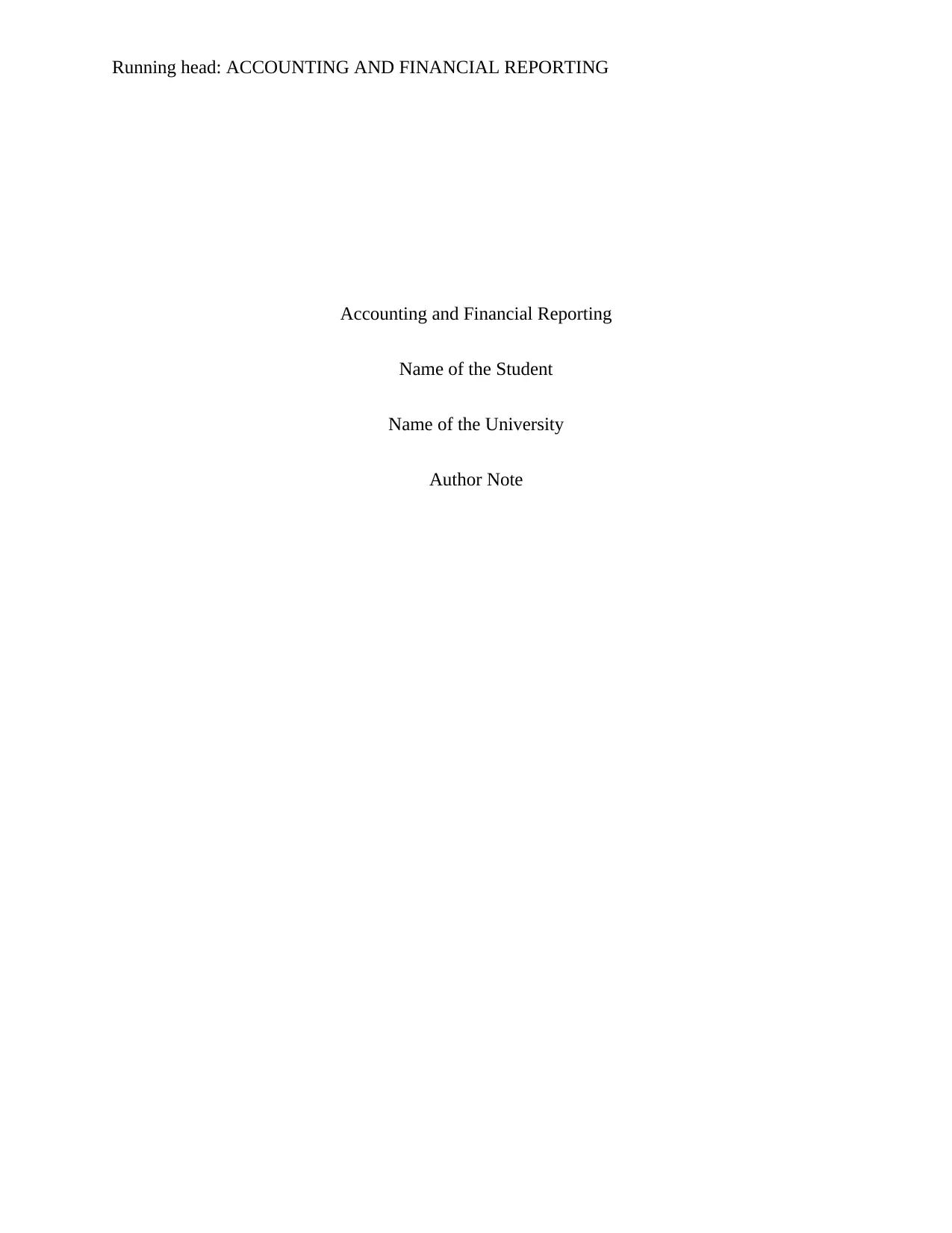
Running head: ACCOUNTING AND FINANCIAL REPORTING
Accounting and Financial Reporting
Name of the Student
Name of the University
Author Note
Accounting and Financial Reporting
Name of the Student
Name of the University
Author Note
Paraphrase This Document
Need a fresh take? Get an instant paraphrase of this document with our AI Paraphraser
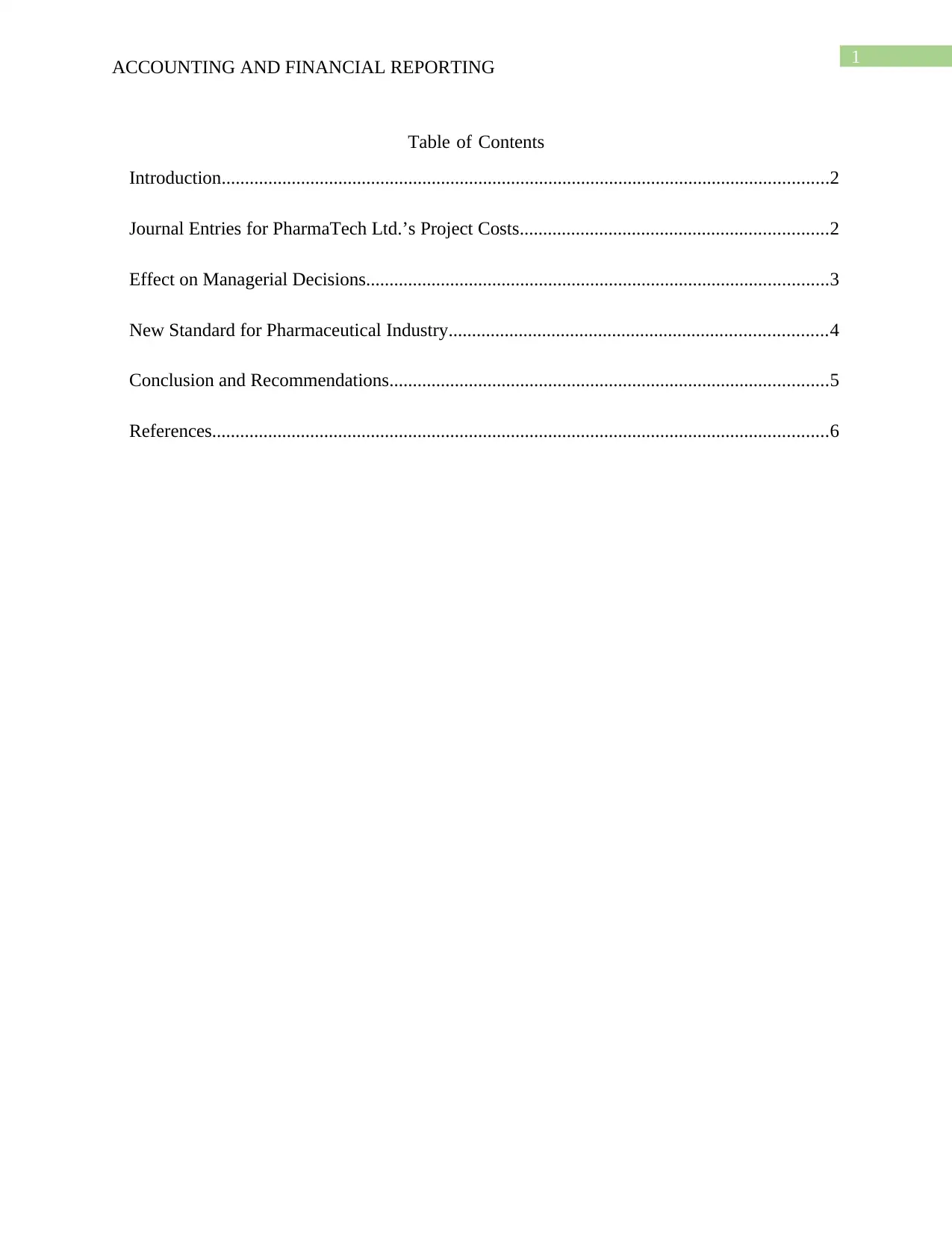
1
ACCOUNTING AND FINANCIAL REPORTING
Table of Contents
Introduction..................................................................................................................................2
Journal Entries for PharmaTech Ltd.’s Project Costs..................................................................2
Effect on Managerial Decisions...................................................................................................3
New Standard for Pharmaceutical Industry.................................................................................4
Conclusion and Recommendations..............................................................................................5
References....................................................................................................................................6
ACCOUNTING AND FINANCIAL REPORTING
Table of Contents
Introduction..................................................................................................................................2
Journal Entries for PharmaTech Ltd.’s Project Costs..................................................................2
Effect on Managerial Decisions...................................................................................................3
New Standard for Pharmaceutical Industry.................................................................................4
Conclusion and Recommendations..............................................................................................5
References....................................................................................................................................6
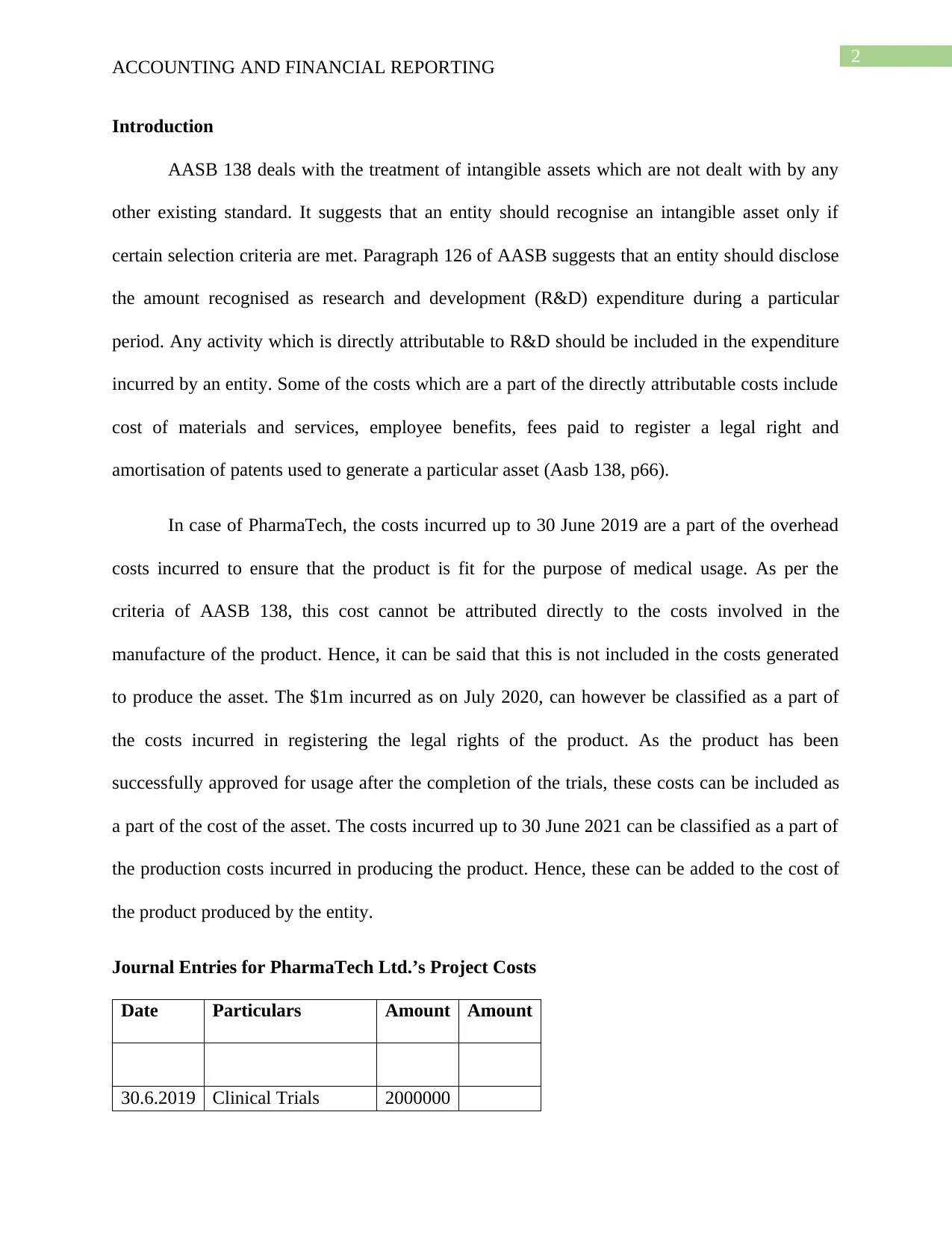
2
ACCOUNTING AND FINANCIAL REPORTING
Introduction
AASB 138 deals with the treatment of intangible assets which are not dealt with by any
other existing standard. It suggests that an entity should recognise an intangible asset only if
certain selection criteria are met. Paragraph 126 of AASB suggests that an entity should disclose
the amount recognised as research and development (R&D) expenditure during a particular
period. Any activity which is directly attributable to R&D should be included in the expenditure
incurred by an entity. Some of the costs which are a part of the directly attributable costs include
cost of materials and services, employee benefits, fees paid to register a legal right and
amortisation of patents used to generate a particular asset (Aasb 138, p66).
In case of PharmaTech, the costs incurred up to 30 June 2019 are a part of the overhead
costs incurred to ensure that the product is fit for the purpose of medical usage. As per the
criteria of AASB 138, this cost cannot be attributed directly to the costs involved in the
manufacture of the product. Hence, it can be said that this is not included in the costs generated
to produce the asset. The $1m incurred as on July 2020, can however be classified as a part of
the costs incurred in registering the legal rights of the product. As the product has been
successfully approved for usage after the completion of the trials, these costs can be included as
a part of the cost of the asset. The costs incurred up to 30 June 2021 can be classified as a part of
the production costs incurred in producing the product. Hence, these can be added to the cost of
the product produced by the entity.
Journal Entries for PharmaTech Ltd.’s Project Costs
Date Particulars Amount Amount
30.6.2019 Clinical Trials 2000000
ACCOUNTING AND FINANCIAL REPORTING
Introduction
AASB 138 deals with the treatment of intangible assets which are not dealt with by any
other existing standard. It suggests that an entity should recognise an intangible asset only if
certain selection criteria are met. Paragraph 126 of AASB suggests that an entity should disclose
the amount recognised as research and development (R&D) expenditure during a particular
period. Any activity which is directly attributable to R&D should be included in the expenditure
incurred by an entity. Some of the costs which are a part of the directly attributable costs include
cost of materials and services, employee benefits, fees paid to register a legal right and
amortisation of patents used to generate a particular asset (Aasb 138, p66).
In case of PharmaTech, the costs incurred up to 30 June 2019 are a part of the overhead
costs incurred to ensure that the product is fit for the purpose of medical usage. As per the
criteria of AASB 138, this cost cannot be attributed directly to the costs involved in the
manufacture of the product. Hence, it can be said that this is not included in the costs generated
to produce the asset. The $1m incurred as on July 2020, can however be classified as a part of
the costs incurred in registering the legal rights of the product. As the product has been
successfully approved for usage after the completion of the trials, these costs can be included as
a part of the cost of the asset. The costs incurred up to 30 June 2021 can be classified as a part of
the production costs incurred in producing the product. Hence, these can be added to the cost of
the product produced by the entity.
Journal Entries for PharmaTech Ltd.’s Project Costs
Date Particulars Amount Amount
30.6.2019 Clinical Trials 2000000
⊘ This is a preview!⊘
Do you want full access?
Subscribe today to unlock all pages.

Trusted by 1+ million students worldwide
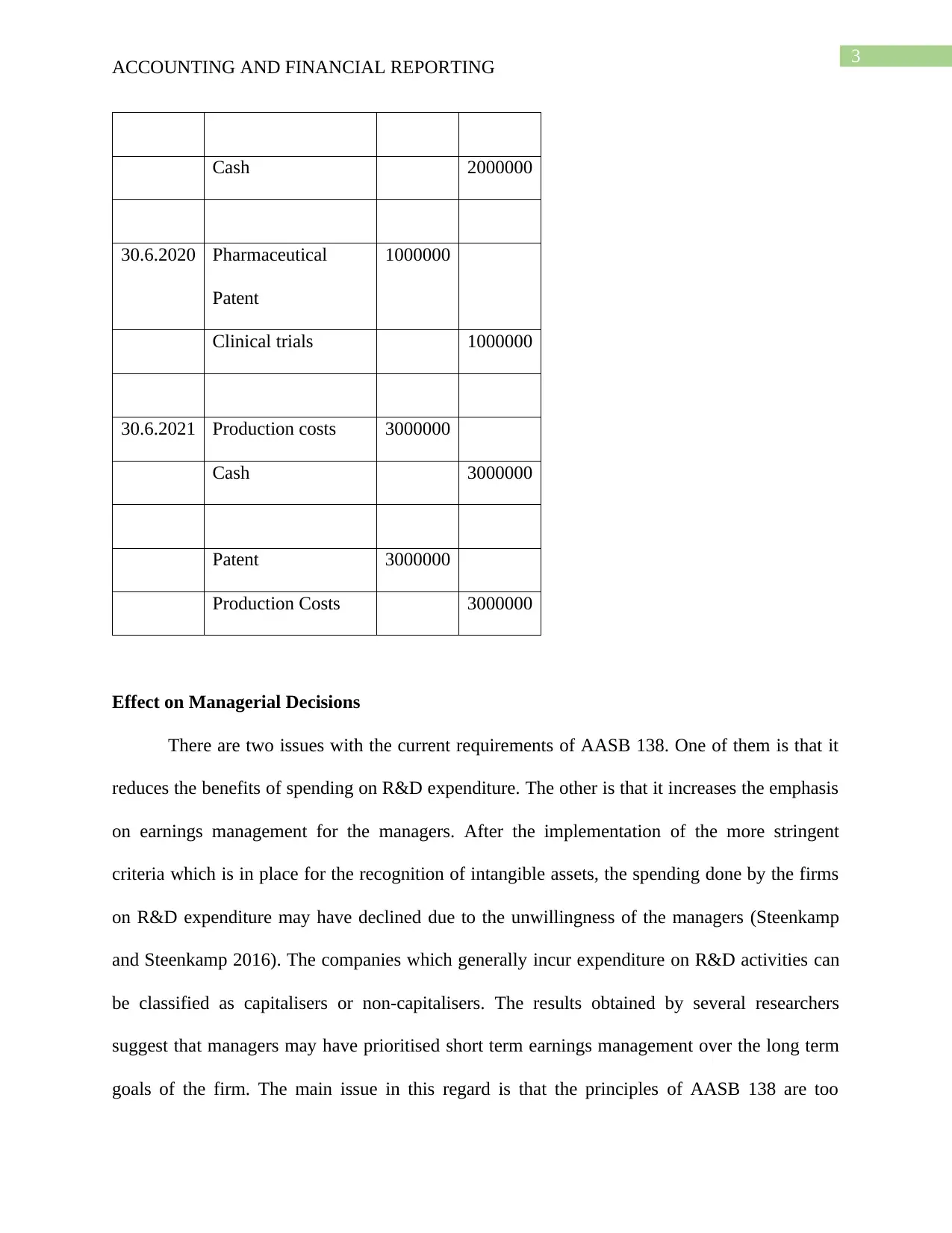
3
ACCOUNTING AND FINANCIAL REPORTING
Cash 2000000
30.6.2020 Pharmaceutical
Patent
1000000
Clinical trials 1000000
30.6.2021 Production costs 3000000
Cash 3000000
Patent 3000000
Production Costs 3000000
Effect on Managerial Decisions
There are two issues with the current requirements of AASB 138. One of them is that it
reduces the benefits of spending on R&D expenditure. The other is that it increases the emphasis
on earnings management for the managers. After the implementation of the more stringent
criteria which is in place for the recognition of intangible assets, the spending done by the firms
on R&D expenditure may have declined due to the unwillingness of the managers (Steenkamp
and Steenkamp 2016). The companies which generally incur expenditure on R&D activities can
be classified as capitalisers or non-capitalisers. The results obtained by several researchers
suggest that managers may have prioritised short term earnings management over the long term
goals of the firm. The main issue in this regard is that the principles of AASB 138 are too
ACCOUNTING AND FINANCIAL REPORTING
Cash 2000000
30.6.2020 Pharmaceutical
Patent
1000000
Clinical trials 1000000
30.6.2021 Production costs 3000000
Cash 3000000
Patent 3000000
Production Costs 3000000
Effect on Managerial Decisions
There are two issues with the current requirements of AASB 138. One of them is that it
reduces the benefits of spending on R&D expenditure. The other is that it increases the emphasis
on earnings management for the managers. After the implementation of the more stringent
criteria which is in place for the recognition of intangible assets, the spending done by the firms
on R&D expenditure may have declined due to the unwillingness of the managers (Steenkamp
and Steenkamp 2016). The companies which generally incur expenditure on R&D activities can
be classified as capitalisers or non-capitalisers. The results obtained by several researchers
suggest that managers may have prioritised short term earnings management over the long term
goals of the firm. The main issue in this regard is that the principles of AASB 138 are too
Paraphrase This Document
Need a fresh take? Get an instant paraphrase of this document with our AI Paraphraser
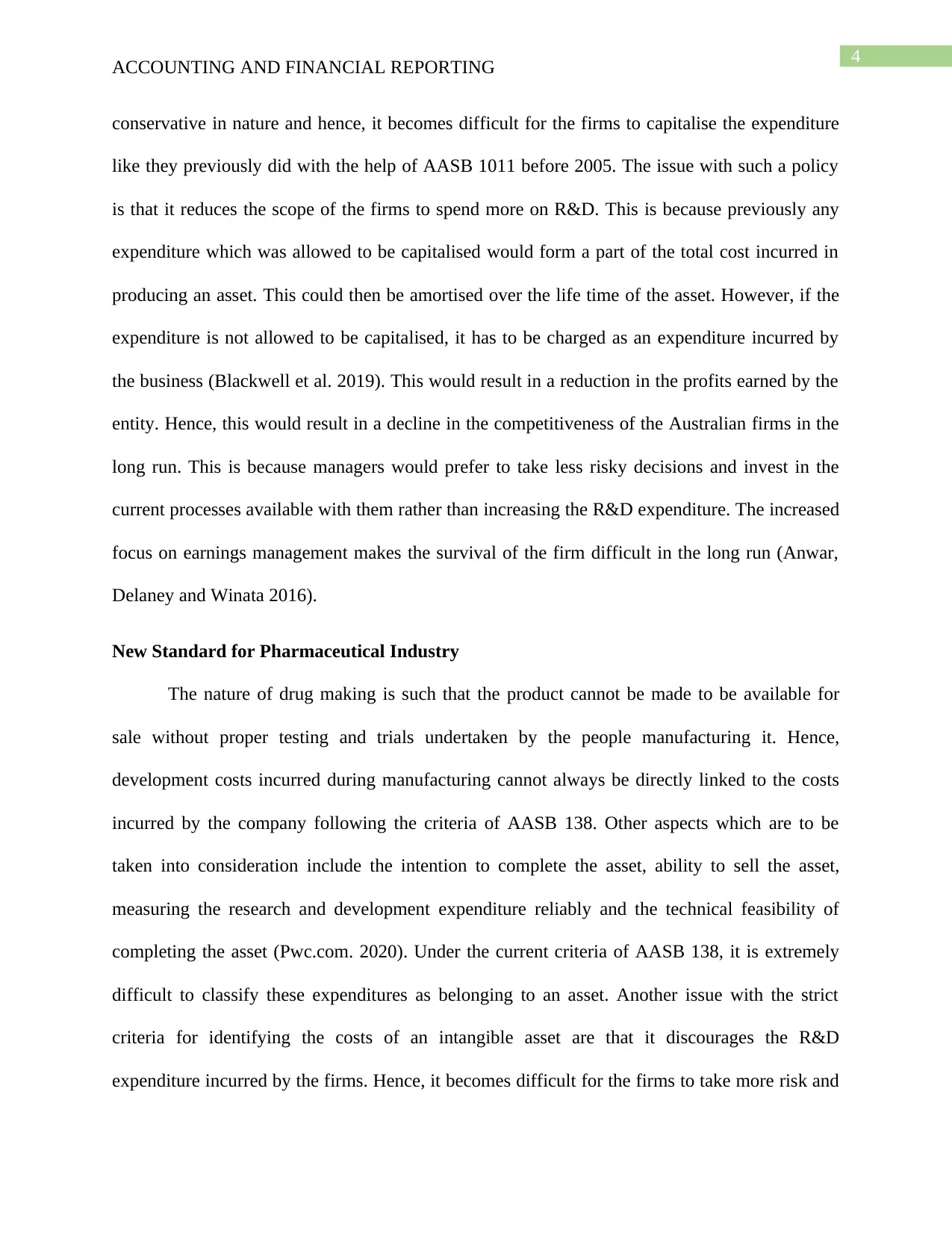
4
ACCOUNTING AND FINANCIAL REPORTING
conservative in nature and hence, it becomes difficult for the firms to capitalise the expenditure
like they previously did with the help of AASB 1011 before 2005. The issue with such a policy
is that it reduces the scope of the firms to spend more on R&D. This is because previously any
expenditure which was allowed to be capitalised would form a part of the total cost incurred in
producing an asset. This could then be amortised over the life time of the asset. However, if the
expenditure is not allowed to be capitalised, it has to be charged as an expenditure incurred by
the business (Blackwell et al. 2019). This would result in a reduction in the profits earned by the
entity. Hence, this would result in a decline in the competitiveness of the Australian firms in the
long run. This is because managers would prefer to take less risky decisions and invest in the
current processes available with them rather than increasing the R&D expenditure. The increased
focus on earnings management makes the survival of the firm difficult in the long run (Anwar,
Delaney and Winata 2016).
New Standard for Pharmaceutical Industry
The nature of drug making is such that the product cannot be made to be available for
sale without proper testing and trials undertaken by the people manufacturing it. Hence,
development costs incurred during manufacturing cannot always be directly linked to the costs
incurred by the company following the criteria of AASB 138. Other aspects which are to be
taken into consideration include the intention to complete the asset, ability to sell the asset,
measuring the research and development expenditure reliably and the technical feasibility of
completing the asset (Pwc.com. 2020). Under the current criteria of AASB 138, it is extremely
difficult to classify these expenditures as belonging to an asset. Another issue with the strict
criteria for identifying the costs of an intangible asset are that it discourages the R&D
expenditure incurred by the firms. Hence, it becomes difficult for the firms to take more risk and
ACCOUNTING AND FINANCIAL REPORTING
conservative in nature and hence, it becomes difficult for the firms to capitalise the expenditure
like they previously did with the help of AASB 1011 before 2005. The issue with such a policy
is that it reduces the scope of the firms to spend more on R&D. This is because previously any
expenditure which was allowed to be capitalised would form a part of the total cost incurred in
producing an asset. This could then be amortised over the life time of the asset. However, if the
expenditure is not allowed to be capitalised, it has to be charged as an expenditure incurred by
the business (Blackwell et al. 2019). This would result in a reduction in the profits earned by the
entity. Hence, this would result in a decline in the competitiveness of the Australian firms in the
long run. This is because managers would prefer to take less risky decisions and invest in the
current processes available with them rather than increasing the R&D expenditure. The increased
focus on earnings management makes the survival of the firm difficult in the long run (Anwar,
Delaney and Winata 2016).
New Standard for Pharmaceutical Industry
The nature of drug making is such that the product cannot be made to be available for
sale without proper testing and trials undertaken by the people manufacturing it. Hence,
development costs incurred during manufacturing cannot always be directly linked to the costs
incurred by the company following the criteria of AASB 138. Other aspects which are to be
taken into consideration include the intention to complete the asset, ability to sell the asset,
measuring the research and development expenditure reliably and the technical feasibility of
completing the asset (Pwc.com. 2020). Under the current criteria of AASB 138, it is extremely
difficult to classify these expenditures as belonging to an asset. Another issue with the strict
criteria for identifying the costs of an intangible asset are that it discourages the R&D
expenditure incurred by the firms. Hence, it becomes difficult for the firms to take more risk and
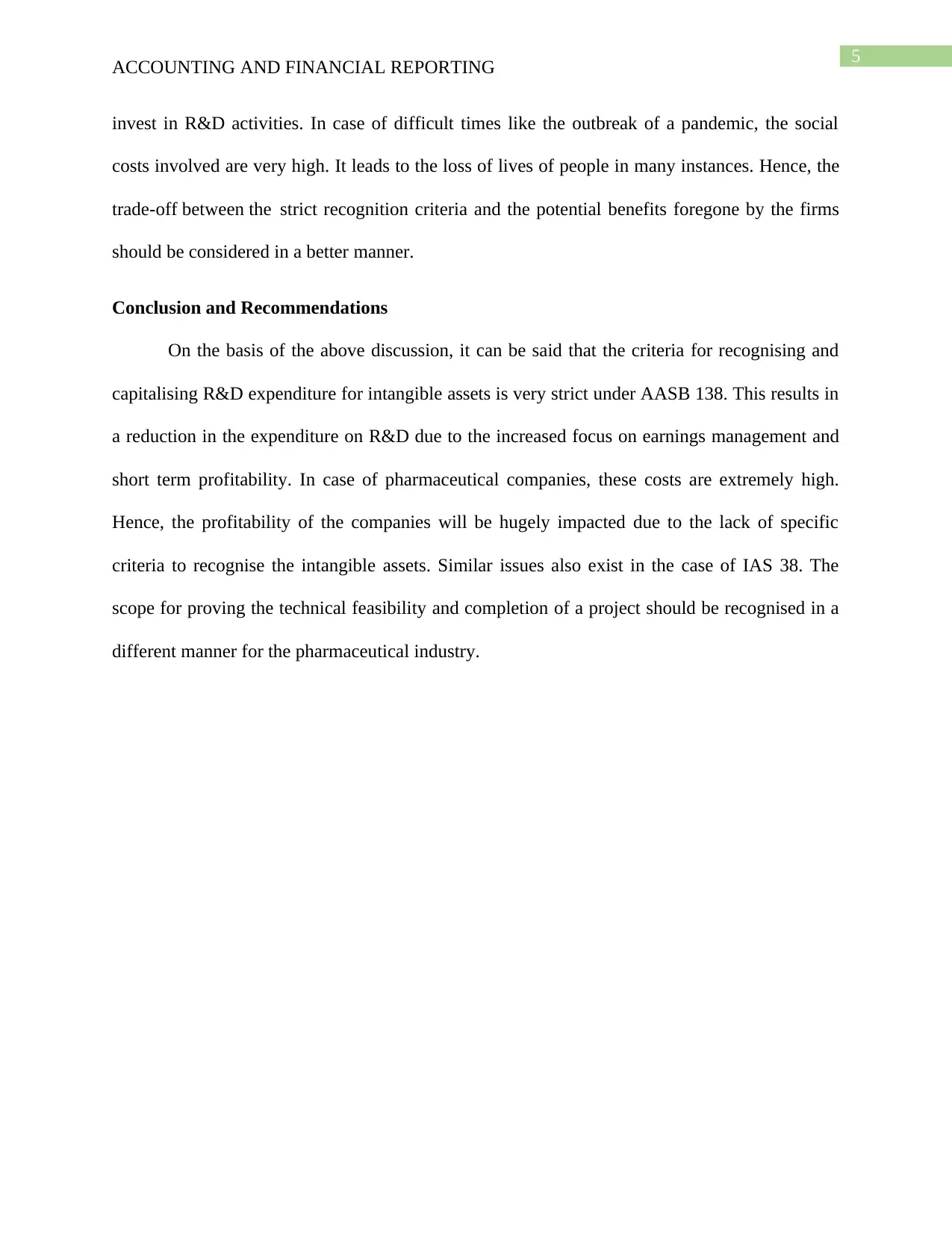
5
ACCOUNTING AND FINANCIAL REPORTING
invest in R&D activities. In case of difficult times like the outbreak of a pandemic, the social
costs involved are very high. It leads to the loss of lives of people in many instances. Hence, the
trade-off between the strict recognition criteria and the potential benefits foregone by the firms
should be considered in a better manner.
Conclusion and Recommendations
On the basis of the above discussion, it can be said that the criteria for recognising and
capitalising R&D expenditure for intangible assets is very strict under AASB 138. This results in
a reduction in the expenditure on R&D due to the increased focus on earnings management and
short term profitability. In case of pharmaceutical companies, these costs are extremely high.
Hence, the profitability of the companies will be hugely impacted due to the lack of specific
criteria to recognise the intangible assets. Similar issues also exist in the case of IAS 38. The
scope for proving the technical feasibility and completion of a project should be recognised in a
different manner for the pharmaceutical industry.
ACCOUNTING AND FINANCIAL REPORTING
invest in R&D activities. In case of difficult times like the outbreak of a pandemic, the social
costs involved are very high. It leads to the loss of lives of people in many instances. Hence, the
trade-off between the strict recognition criteria and the potential benefits foregone by the firms
should be considered in a better manner.
Conclusion and Recommendations
On the basis of the above discussion, it can be said that the criteria for recognising and
capitalising R&D expenditure for intangible assets is very strict under AASB 138. This results in
a reduction in the expenditure on R&D due to the increased focus on earnings management and
short term profitability. In case of pharmaceutical companies, these costs are extremely high.
Hence, the profitability of the companies will be hugely impacted due to the lack of specific
criteria to recognise the intangible assets. Similar issues also exist in the case of IAS 38. The
scope for proving the technical feasibility and completion of a project should be recognised in a
different manner for the pharmaceutical industry.
⊘ This is a preview!⊘
Do you want full access?
Subscribe today to unlock all pages.

Trusted by 1+ million students worldwide
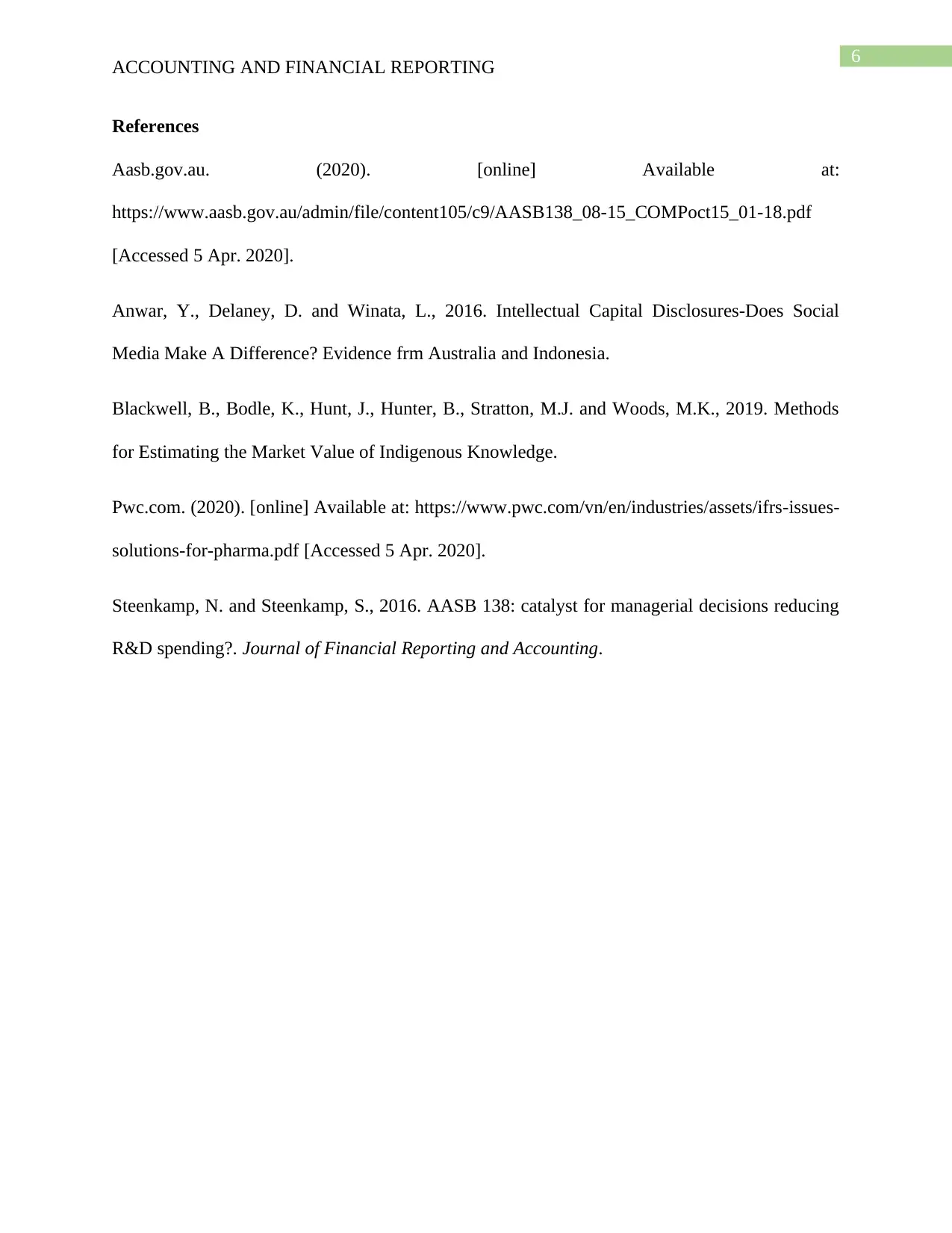
6
ACCOUNTING AND FINANCIAL REPORTING
References
Aasb.gov.au. (2020). [online] Available at:
https://www.aasb.gov.au/admin/file/content105/c9/AASB138_08-15_COMPoct15_01-18.pdf
[Accessed 5 Apr. 2020].
Anwar, Y., Delaney, D. and Winata, L., 2016. Intellectual Capital Disclosures-Does Social
Media Make A Difference? Evidence frm Australia and Indonesia.
Blackwell, B., Bodle, K., Hunt, J., Hunter, B., Stratton, M.J. and Woods, M.K., 2019. Methods
for Estimating the Market Value of Indigenous Knowledge.
Pwc.com. (2020). [online] Available at: https://www.pwc.com/vn/en/industries/assets/ifrs-issues-
solutions-for-pharma.pdf [Accessed 5 Apr. 2020].
Steenkamp, N. and Steenkamp, S., 2016. AASB 138: catalyst for managerial decisions reducing
R&D spending?. Journal of Financial Reporting and Accounting.
ACCOUNTING AND FINANCIAL REPORTING
References
Aasb.gov.au. (2020). [online] Available at:
https://www.aasb.gov.au/admin/file/content105/c9/AASB138_08-15_COMPoct15_01-18.pdf
[Accessed 5 Apr. 2020].
Anwar, Y., Delaney, D. and Winata, L., 2016. Intellectual Capital Disclosures-Does Social
Media Make A Difference? Evidence frm Australia and Indonesia.
Blackwell, B., Bodle, K., Hunt, J., Hunter, B., Stratton, M.J. and Woods, M.K., 2019. Methods
for Estimating the Market Value of Indigenous Knowledge.
Pwc.com. (2020). [online] Available at: https://www.pwc.com/vn/en/industries/assets/ifrs-issues-
solutions-for-pharma.pdf [Accessed 5 Apr. 2020].
Steenkamp, N. and Steenkamp, S., 2016. AASB 138: catalyst for managerial decisions reducing
R&D spending?. Journal of Financial Reporting and Accounting.
1 out of 7
Related Documents
Your All-in-One AI-Powered Toolkit for Academic Success.
+13062052269
info@desklib.com
Available 24*7 on WhatsApp / Email
![[object Object]](/_next/static/media/star-bottom.7253800d.svg)
Unlock your academic potential
Copyright © 2020–2025 A2Z Services. All Rights Reserved. Developed and managed by ZUCOL.



